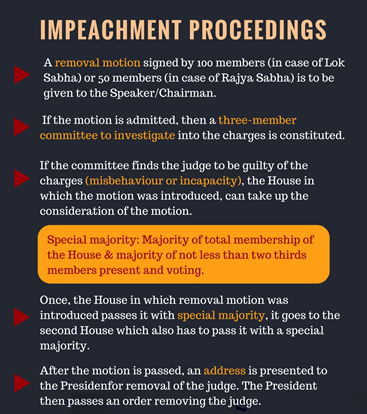Table of Contents
Context
- The recent comments made by Karnataka High Court Justice V Srishananda, which included referring to a locality in Bengaluru as being “in Pakistan” and making an objectionable remark against a female lawyer, have highlighted the challenges the judiciary faces in disciplining judges of constitutional courts.
- While the Supreme Court (SC) expressed serious concern, the issue underscores the constitutional limitations on holding judges accountable and the alternative mechanisms developed by the judiciary.
Constitutional Limitations on Disciplining Judges
- Impeachment: The Sole Recourse
- The Constitution provides impeachment as the only formal process to remove judges of constitutional courts.
- As per Article 124 (for the removal of a Supreme Court judge) and Article 218 (for the removal of a high court judge) a judge can only be removed for “proved misbehaviour or incapacity” through an order by the President after an address by both Houses of Parliament, supported by a majority of the total membership and two-thirds of the members present and voting.
- The high threshold for impeachment, requiring political consensus, makes it difficult to hold judges accountable unless there is overwhelming evidence of misconduct.

- Impeachment Proceedings in India:
- Impeachment has been initiated only five times in Indian history:
- Justice V Ramaswami (Supreme Court, 1993)
- Justice Soumitra Sen (Calcutta High Court, 2011)
- Justice J B Pardiwala (Gujarat High Court, 2015)
- Justice C V Nagarjuna (High Court of Andhra Pradesh and Telangana, 2017)
- Then CJI Justice Dipak Misra (2018)
- None of these proceedings led to successful impeachment, although Justice Soumitra Sen was impeached by the Rajya Sabha and resigned subsequently.
- Impeachment has been initiated only five times in Indian history:
- Challenges Beyond Impeachment:
- Various forms of judicial misconduct, such as indiscipline, bias, petty corruption, or questionable conduct, often do not meet the high standard for impeachment.
- The absence of alternatives to impeachment means errant judges are often left unchecked unless alternative disciplinary measures are employed.
Alternative Measures for Disciplining Judges
- Judicial Intervention: The Supreme Court can intervene through judicial action, as seen in past cases where judges faced contempt charges for misconduct.
- Case of C.S. Karnan: In 2017, Justice C.S. Karnan was sentenced to six months in prison for contempt due to his actions as a judge. This case raised concerns about one constitutional court taking action against another.
- Transfer Policy: The Supreme Court Collegium has the authority to recommend transfers of High Court judges as a disciplinary measure.
- Justice P.D. Dinakaran’s Case: Dinakaran was transferred amid corruption allegations while removal proceedings were ongoing, leading to criticism that this merely “transferred corruption.”
Implications and Criticism
- Judicial Independence vs. Accountability:
- Judges of constitutional courts enjoy significant protection to ensure judicial independence, yet this also creates a gap in accountability.
- The only formal recourse, impeachment, is often unviable due to the high threshold and political complexities involved.
- Concerns Over Alternative Measures:
- The use of judicial intervention and the transfer policy, though pragmatic, raises questions about transparency and the potential misuse of these mechanisms.
- Critics argue that these measures while serving as interim solutions, do not address the root cause of judicial misconduct and may undermine public confidence in the judiciary.
Call for Reforms
- The situation calls for a reevaluation of disciplinary mechanisms within the judiciary to strike a balance between independence and accountability.
- There is a need to explore reforms that provide alternative, transparent, and effective ways to discipline judges without compromising the core principles of judicial independence.
Conclusion
The case of Justice Srishananda and other similar incidents underline the challenges in disciplining judges within India’s constitutional framework. With impeachment being a difficult and rarely successful recourse, the judiciary has adopted alternative methods such as judicial intervention and transfers, which, while necessary, are not without controversy. The debate continues on how best to ensure judicial accountability while safeguarding the independence that is crucial to the functioning of India’s judiciary.


 Bharat Bandh 9 July 2025: Over 25 Crore ...
Bharat Bandh 9 July 2025: Over 25 Crore ...
 Sukhoi Su-57: Will India Choose Russia�...
Sukhoi Su-57: Will India Choose Russia�...
 World Bioproduct Day 2025: Date, Theme, ...
World Bioproduct Day 2025: Date, Theme, ...





















